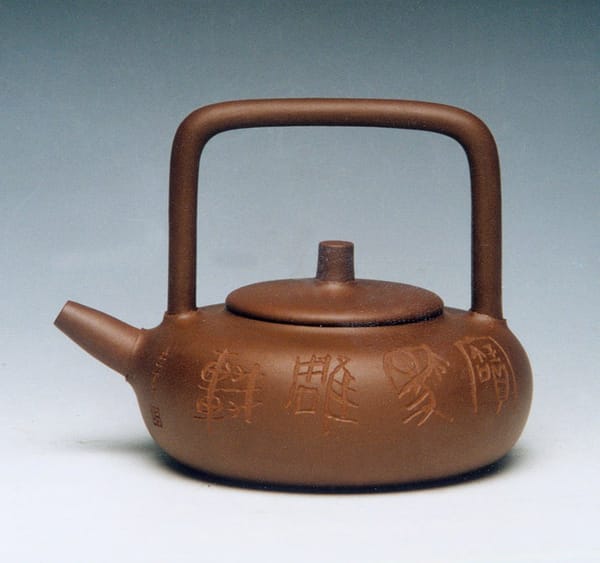The Art of Chinese Teapots: Merging Aesthetics with the Tea Experience
Have you ever cradled a finely crafted Yixing teapot or a delicate blue-and-white porcelain pot in the afternoon sun, feeling its warmth in your hands? In that moment, you're not merely awaiting a cup of tea; you're engaging in a silent dialogue between soul and teaware. A teapot, though simple in form, carries profound cultural significance. It embodies millennia of tea culture and bears witness to the present tea-drinking moment. Throughout the long history of Chinese tea culture, teapots have served not only as functional vessels but also as exquisite works of art and vital links between people and tea.
When savoring a fine tea, quality leaves take center stage, water quality is the soul, and the teapot acts as the director of this performance. Its precise capacity ensures the optimal ratio of tea leaves to water, while its intricate ornamentation subtly conveys Chinese cultural sentiments. Through each infusion, the teapot orchestrates the perfect tea experience. A well-crafted teapot allows the tea's flavors to fully unfold, transforming tea drinking into an art form.
Let's delve into the nuanced world of teapots, exploring how to select the appropriate capacity and ornamentation to elevate your tea experience. Whether you're a seasoned tea connoisseur or a novice, understanding how to choose the right teapot will enhance your tea sessions.
Teapot Capacity: A Subtle Science
The Hidden Order Behind Teapot Capacity: A Key Factor in Tea Quality
The phrase "a world within a teapot" may sound poetic, but for tea enthusiasts, it's a tangible reality. A teapot's capacity isn't merely about how much water it holds; it's about providing space for tea leaves to unfurl, allowing tea liquor to flow freely, and ultimately influencing the flavor profile.
You might have heard terms like "three-cup," "six-cup," or "eight-cup" teapots. These colloquial expressions refer to the number of cups a teapot can yield in one brew. Though seemingly vague, they encapsulate wisdom—teapot capacity, tea leaf quantity, water temperature, and steeping time are interconnected, forming a complex network that governs the "hidden order" of tea infusion.
During the Tang and Song dynasties, people recognized this. The "Jie Tea Notes" states: "Teapots made of kiln-fired clay are superior, and smaller ones are more esteemed. A small pot retains aroma and flavor without delay." The size of the teapot directly affects the preservation of aroma and the release of flavor. This isn't superstition but empirical knowledge grounded in physics and chemistry.
The Evolution of Chinese Teapots: From "Water Pourers" to "Soup Bottles" and the Development of Tea Culture
Historically, the terminology for teapots evolved alongside tea preparation methods. In the Tang dynasty, they were called "water pourers" or "pouring vessels"; by the Song dynasty, they became known as "soup bottles" or "soup dispensers." While the names changed, their function remained—to hold and pour water for brewing tea.
The Tang dynasty's tea preparation required specially designed teapots: typically short-necked, round-bellied, with curved handles. This design helped maintain water temperature, enhancing the release of tea aroma. Emperor Huizong of the Song dynasty noted in "Treatise on Tea": "A slightly larger and straight spout ensures a strong, focused pour. A small, sharp spout tip allows controlled pouring without dripping." Clearly, spout design significantly influences water flow control.
These teapots weren't just containers; they were precision tools crafted for tea ceremonies. Renowned kilns like Changsha, Yaozhou, and Shouzhou produced water pourers with unique shapes and exquisite craftsmanship, becoming the "brand products" of their time, exported abroad as tangible evidence of the Tang dynasty's flourishing tea culture.
How to Choose the Right Teapot Capacity: A Modern Guide
Today, selecting a teapot still requires careful consideration of capacity. Different tea types indeed respond differently to teapot size:
- Small Teapots: Ideal for premium teas, oolong, and ripe pu-erh, which require careful savoring. Small pots concentrate aroma and ensure uniformity in each brew.
- Large Teapots: Suitable for fragrant green teas, floral teas, or group settings, providing ample tea for multiple guests.
A teapot's capacity and shape reflect the artisan's skill and aesthetic. A good teapot should be both "exquisite"—graceful and fluid in lines—and "grand"—crafted with boldness and imagination. Regardless of size, it should feel comfortable and natural in the user's hand, achieving the pinnacle of teapot selection.
Teapot Ornamentation: A Feast for the Eyes and Soul
The Art of Teapot Ornamentation: Cultural Significance in Every Detail
Ornamentation on teapots isn't merely decorative; it bridges visual and gustatory experiences, enhancing the overall sensory journey of tea drinking. Ancient artisans depicted landscapes, figures, flora, and fauna on teapots, expressing artistic vision, reverence for nature, and reflections on life and values.
Imagine a simple pattern on a Changsha kiln water pourer capturing a Tang dynasty painter's brushwork; a cloud motif beneath the glaze conveying a Song dynasty scholar's mood. Teapot ornamentation freezes time and perpetuates culture.
Common motifs include:
- Lotus Petals: Symbolizing purity and Buddhist ideals.
- Mountains and Rocks: Reflecting scholars' yearning for nature.
- Pine Trees: Representing resilience and longevity.
- Dragons, Qilin, Lions: Denoting auspiciousness and authority.
These designs are not only visually appealing but also rich in cultural symbolism, making each teapot a miniature cultural epic.
Ornamentation Styles Across Dynasties
Teapot ornamentation styles varied significantly across dynasties:
- Tang Dynasty: Emphasized practicality with bold, simple designs, such as geometric or plant motifs on Changsha kiln blue-glazed water pourers.
- Song Dynasty: Pursued elegance with subtle, refined patterns, like the carved decorations on Yaozhou kiln celadon water pourers.
- Yuan Dynasty: Featured grand, expressive motifs, including dynamic depictions of flora and fauna on blue-and-white porcelain.
- Ming Dynasty: Showcased diverse themes with intricate craftsmanship, portraying landscapes, figures, and animals on blue-and-white porcelain.
- Qing Dynasty: Known for lavish, complex designs, especially in imperial kiln pieces, each meticulously crafted with opulence.
These stylistic evolutions allow us to glimpse historical changes and aesthetic developments through teapot ornamentation. Holding a blue-and-white teapot connects you not only to tea but also to history and ancient artisans.
The Sensory Delight of Ornamentation
Teapot ornamentation offers more than static visuals; it provides dynamic sensory experiences during use. Imagine pouring hot water into a teapot, watching steam rise as the glaze's colors shift and patterns subtly emerge—this visual interplay enriches the tea-drinking process.
As someone once said, "Ornamentation embodies natural vitality, immersing the user in sensory pleasure." Each line and motif on a teapot can, in a fleeting moment, harmon


